Apple
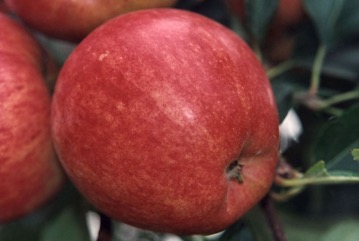
It is a temperate plant. It is grown at altitude in the tropics. In the tropics a short growth cycle requires mild temperatures throughout the year. This is found near the equator at altitudes of 800-1200 m where temperatures are 16-27°C. A rainfall of 1600-3200 mm and a relative humidity of 75-85%. The growing season should have good sunlight while the off season should be overcaste and cool. Most apple varieties require 1,000 hours of chilling at temperatures below 7°C during the dormant season. In the Himalayas this occurs between 1,400-2,800 m altitude. Low chilling varieties occur. It suits hardiness zones 3-9.
Also known as:
Amra, Ao zhou, Apel, Apfelbaum, Appel, Appoen, Buah apel, Koduounapuu, Mansanas, Manzana, Manzano, Melo, Ounapuu, Parisounapuu, Pom, Pommelier, Pommier, Saib, Seb, Syau, Yabloko
Synonyms
- Malus communis Poir. ex Lamk. (in part) Malus x domestica
- Malus malus (L.) Britton, nom. inval.
- Malus pumila auct. non Miller
- Malus sylvestris auct.
- Malus sylvestris var. domestica (Borkh.) Mansf.
- Pyrus malus L. (in part)
Edible Portion
- Fruit
Where does Apple grow?
Found in: Africa, Albania, Argentina, Armenia, Australia, Azerbaijan, Balkans, Brazil, Britain, Cameroon, Caucasus, Central Africa, Central America, Central Asia, China, Cook Islands, Costa Rica, Cuba, East Africa, East Timor, Estonia, Ethiopia, Europe, Falklands, Finland, France, Georgia, Germany, Hawaii, Himalayas, Hungary, India, Indochina, Indonesia, Iran, Israel, Italy, Japan, Kazakhstan, Kyrgyzstan, Lithuania, Macedonia, Malawi, Mediterranean, Mexico, Moldova, Nepal, North America, Pacific, Pakistan, Papua New Guinea, PNG, Philippines, Poland, Russia, Scandinavia, SE Asia, Serbia, Sikkim, Slovenia, South America, Spain, Switzerland, Tajikistan, Tasmania, Thailand, Timor-Leste, Turkey, Ukraine, Uruguay, United States, Uzbekistan, Zimbabwe
Notes: There are about 35 Malus species and very many cultivated varieties. The apple is a hybrid probably of Malus sylvestris, Malus dasyphylla and Malus pumila.
Growing Apple
Cultivation: Plats are grown by seed and by grafting. In the tropics the plants are almost evergreen with little shoot growth and flowers and fruiting can occur throughout the year. To produce consistent fruiting, branches and bent horizontal and tied down. Sometimes leaves are picked off. The importance or cross pollination is less important in the tropics. Apples are normally produce by budding using shoots of good clones. In Indonesia a root stock from wild apple is produced by root suckers or air layering. The dormancy of seeds is broken by putting them in a freezer for 30-150 days.
Edible Uses: The fruit are eaten fresh. They are also cooked and used to make juice. The fruit can be sliced and dried. Caution: Apples seeds contain amygdalin a cyanogenic glucoside.
Production: The fruit ripen 3.5-5 months after flowering. In the tropics flower buds can greatly exceed leaf buds so trees can produce more fruit than the leaves can support. Fruit thinning is then necessary.
Nutrition Info
per 100g edible portion| Edible Part | Energy (kcal) | Protein (g) | Iron (mg) | Vitamin A (ug) | Vitamin c (mg) | Zinc (mg) | % Water |
|---|---|---|---|---|---|---|---|
| Fruit | 56 | 0.3 | - | - | 10 | - | 85 |
Apple Photos

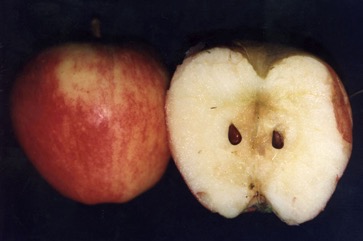
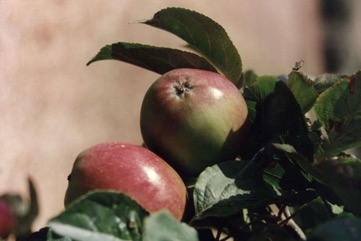
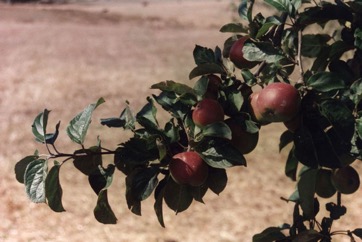
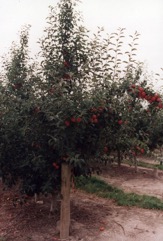
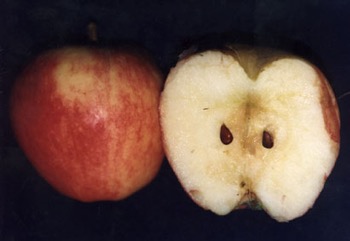
References
Ambasta, S.P. (Ed.), 2000, The Useful Plants of India. CSIR India. p 351 (As Malus pumila)
Awan, M. R., et al, 2011, Studies on traditional knowledge of economically important plants of Kaghan Valley, Mansehra District, Pakistan. Journal of Medicinal Plants Research Vol. 5(16), pp. 3958-3967
Bianchini, F., Corbetta, F., and Pistoia, M., 1975, Fruits of the Earth. Cassell. p 126
Bodkin, F., 1991, Encyclopedia Botanica. Cornstalk publishing, p 858 (As Pyrus malus)
Bourke, R. M., Altitudinal limits of 230 economic crop species in Papua New Guinea. Terra australis 32.
Bussman, R. W., et al, 2016, A comparative ethnobotany of Khevsureti, Samtskhe-Javakheti, Tusheti, Svaneti, and Racha-Lechkhumi, Republic of Georgia (Sakartvelo), Caucasus. Journal of Ethnobiology and Ethnomedicine.
Bussman, R. W. et al, 2017, Ethnobotany of Samtskhe-Javakheti, Sakartvelo (Republic of Georgia), Caucasus. Indian Journal of Traditional Knowledge Vol. 16(1) pp 7-24
Call, C. A., et al, 2004, Participatory Rural Appraisal in the Upland Ecosystem of Mt Malindang, Misamis Occidental, Philippines. Biodiversity Research Programme for Development in Mindanao. p 53 (As Pyrus malus)
Chandrashekara, U. M., 2009, Tree species yielding edible fruit in the coffee-based homegardens of Kerala, India: their diversity, uses and management. Food Sec. 1:361-370 (As Pyrus malus)
Cheifetz, A., (ed), 1999, 500 popular vegetables, herbs, fruits and nuts for Australian Gardeners. Random House p 201
Coombes, A.J., 2000, Trees. Dorling Kindersley Handbooks. p 246
Cruz, I. M., et al, 2015, Edible fruits and seeds in the State of Mexico. Revista Mexicana de Ciencias Agricolas. Vol. 6. Num. 2 pp 331-346
Cundall, P., (ed.), 2004, Gardening Australia: flora: the gardener's bible. ABC Books. p 862 (Probably now Malus pumila)
Dharani, N., 2002, Field Guide to common Trees & Shrubs of East Africa. Struik. p 247
Etherington, K., & Imwold, D., (Eds), 2001, Botanica's Trees & Shrubs. The illustrated A-Z of over 8500 trees and shrubs. Random House, Australia. p 461
Flowerdew, B., 2000, Complete Fruit Book. Kyle Cathie Ltd., London. p 18
Glowinski, L., 1999, The Complete Book of Fruit Growing in Australia. Lothian. p 1
INFOODS:FAO/INFOODS Databases
INFOODS:FAO/INFOODS Databases (As Pyrus malus)
Jardin, C., 1970, List of Foods Used In Africa, FAO Nutrition Information Document Series No 2.p 146
Kalle, R. & Soukand, R., 2012, Historical ethnobotanical review of wild edible plants of Estonia (1770s-1960s) Acta Societatis Botanicorum Poloniae 81(4):271-281
Kapelle, M., et al, 2000, Useful plants within a Campesino Community in a Costa Rican Montane Cloud Forest. Mountain Research and Development, 20(2): 162-171 (As Malus pumila)
Khan, D. & Shaukat, S.S., 2006, The Fruits of Pakistan: Diversity, Distribution, Trends of Production and Use. Int. J. Biol. Biotech., 3(3):463-499 (As Malus pumila)
Larios, et al., 2013, Plant management and biodiversity conservation in Náhuatl homegardens of the Tehuacán Valley, Mexico. Journal of Ethnobiology and Ethnomedicine 2013 9:74.
Lazarides, M. & Hince, B., 1993, Handbook of Economic Plants of Australia, CSIRO. p 158
Lord, E.E., & Willis, J.H., 1999, Shrubs and Trees for Australian gardens. Lothian. p 61
Lorenzi, H., Bacher, L., Lacerda, M. & Sartori, S., 2006, Brazilian Fruits & Cultivated Exotics. Sao Paulo, Instituto Plantarum de Estuados da Flora Ltda. p 492
Łukasz Łuczaj and Wojciech M Szymański, 2007, Wild vascular plants gathered for consumption in the Polish countryside: a review. J Ethnobiol Ethnomedicine. 3: 17
Lyle, S., 2006, Discovering fruit and nuts. Land Links. p 278
Macmillan, H.F. (Revised Barlow, H.S., et al) 1991, Tropical Planting and Gardening. Sixth edition. Malayan Nature Society. Kuala Lumpur. p 318 (As Pyrus malus)
Manandhar, N.P., 2002, Plants and People of Nepal. Timber Press. Portland, Oregon. p 387 (As Pyrus malus)
Molla, A., Ethiopian Plant Names. http://www.ethiopic.com/aplants.htm
Paul, A., 2013, Minor and uncultivated fruits of Eastern India, 2nd International Symposium on Minor Fruits and Medicinal Plants
Pieroni, A., 1999, Gathered wild food plants in the Upper Valley of the Serchio River (Garfagnana), Central Italy. Economic Botany 53(3) pp 327-341
Pieroni, A., et al, 2005, Food for two seasons: Culinary uses of non-cultivated local vegetables and mushrooms in a south Italian village. International Journal of Food Sciences and Nutrition, 56(4): 245-272
Plants for a Future database, The Field, Penpol, Lostwithiel, Cornwall, PL22 0NG, UK. http://www.scs.leeds.ac.uk/pfaf/
Polunin, O., & Stainton, A., 2006, Flowers of the Himalaya, Oxford India Paperbacks. p 121
PROSEA (Plant Resources of South East Asia) handbook, Volume 2, 1991, Edible fruits and nut. p 198
Segura, S., et al, 2018, The edible fruit species in Mexico. Genet Resour Crop Evol (2018) 65:1767–1793
Sharma, B.B., 2005, Growing fruits and vegetables. Publications Division. Ministry of Information and broadcasting. India. p 10
Small, E., 2009, Top 100 Food Plants. The world's most important culinary crops. NRC Research Press. p 81
Soukand, R. & Kalle, R., 2016, Perceiving the Biodiversity of Food at Chest-height: use of the Fleshy Fruits of Wild Trees and Shrubs in Saaremaa, Estonia. Hum Ecol 44:265–272
Sp. pl. 1:479. 1753 (As Pyrus malus)
Sukarya, D. G., (Ed.) 2013, 3,500 Plant Species of the Botanic Gardens of Indonesia. LIPI p 669
Tasmanian Herbarium Vascular Plants list p 50
Theor. prakt. Handb. Forstbot. 2:1272. 1803 - fide Telopea 9:427. 2001 an illegitimate, superfluous name (ICBN Art. 52) for M. communis Desf. (1798), i.e. based on the same type (that of Pyrus malus L.)
Upreti, K., et al, 2010, Diversity and Distribution of Wild Edible Fruit Plants of Uttarakhand. Bioversity Potentials of the Himalaya. p 182 (As Pyrus malus L.)
Upson, R., & Lewis R., 2014, Updated Vascular Plant Checklist and Atlas for the Falkland Islands. Falklands Conservation and Kew.
USDA, ARS, National Genetic Resources Program. Germplasm Resources Information Network - (GRIN). [Online Database] National Germplasm Resources Laboratory, Beltsville, Maryland. Available: www.ars-grin.gov/cgi-bin/npgs/html/econ.pl (10 April 2000)
van Wyk, B., 2005, Food Plants of the World. An illustrated guide. Timber press. p 238
Vivien, J., & Faure, J.J., 1996, Fruitiers Sauvages d'Afrique. Especes du Cameroun. CTA p 278
Vlkova, M., et al, 2015, Edible Plants Sold on Marginal Rural Markets in Fergana Valley, Southern Kyrgyzstan. Bulgarian Journal of Agricultural Science, 21 (No 2) 2015, 243–250
Watkins, R., 1979, Apple and Pear, in Simmonds, N.W., (ed), Crop Plant Evolution. Longmans. London. p 247
Williamson, J., 2005, Useful Plants of Malawi. 3rd. Edition. Mdadzi Book Trust. p 159
Wiriadinata, H., 1995, Ethnobotany of Economic Plants in the Baliem Valley, Jayawijaya, Irian Jaya, Indonesian Institute of Science, Bogor, Indonesia (As Pyrus malus)
World Checklist of Useful Plant Species 2020. Royal Botanic Gardens, Kew
http://cookislands.bishopmuseum.org (Malus pumila)